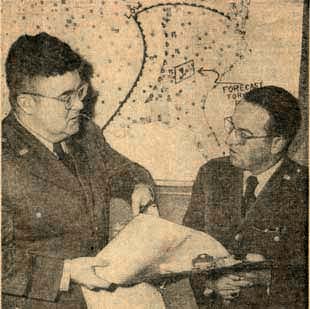An Improbable Forecast
The Californian had little experience with forecasting Midwestern weather. He had been at Tinker Air Force Base in Oklahoma less than three weeks. When World War II broke out, he left his classes at Occidental College where he was enrolled, and enlisted in the Army Air Corps. He ended up in the weather forecaster school in Grand Rapids, Michigan. The demand was so great that new forecasters were put to work after a hurried nine month course in meteorology. His tours of duty were mainly in the South Pacific, forecasting weather for the forces that were battling the Axis. He was eventually promoted to the rank of Captain.
At the end of the war, he was assigned to Fort Benning in Georgia, where he honed his ability to map out the details of weather at different altitudes and visualize those details. This ability to understand a three dimensional picture of the atmosphere is critical to weather forecasting. On the afternoon of March 20, 1948, he plotted the weather at the surface and aloft across the vast and flat terrain of the American Plains. There was nothing on the charts out of the ordinary. It looked like a dry and boring forecast with just some gusty winds through the evening hours.
He settled in to get acquainted with the backup forecaster, who was also from California. About 9 p.m., much to the forecasters’ surprise, they began to see surface reports of lightning from stations just to the southwest and west of Oklahoma City. Echoes appeared on their weather radar, less than twenty minutes away. The backup forecaster, a Staff Sergeant, sat down to type up a warning that thunderstorms were approaching. To their horror, at 9:52 p.m., a report streamed across the teletype from Will Rogers Airport, just seven miles to their southwest that a tornado was on the ground, visible from the airport. Sure enough, illuminated by lightning, a huge funnel was visible almost immediately. It roared across the base, doing $10 million worth of damage and injuring several personnel.
There were recriminations immediately. A panel of investigators from Washington flew in the next morning. The nervous weather officer and his superior answered questions. The board of inquiry listened to the facts and quickly rendered a decision. The event was not forecastable given the state of the art in meteorology. But later that day, Colonel Robert Miller and Major Ernest Fawbush were summoned to the Commanding General’s office. He directed Fawbush and Miller to investigate the possibility of forecasting tornadoes.
They reviewed the weather charts from the day before, as well as those from other tornadic events. They identified that tornadoes seemed to occur in warm, moist airmasses, with strong winds aloft. But the difficulty lay in delineating the areas which were most likely to experience the destructive storms. Issuing a tornado forecast for a single point seemed improbable.
But less than a week later on the 25th, Fawbush and Miller looked at their weather charts and then at each other. The weather pattern looked nearly identical to that of the 20th. What were the odds that another tornado would strike the base? Infinitesimal. They went to the General and told him what they saw. The General ordered the base secured. They reconvened with the General at early afternoon. It was then that they issued the first tornado forecast. Sure enough, a tornado moved across the well prepared base that evening.
It was the beginning of modern tornado forecasting.
Follow my weather history tweets. I am wxhistorian @ twitter.com
Some of this content taken from Mike Smith’s new book “Warnings!” It will be released on May 1st. Mike will be telling the story of how effective the severe weather warning system has become in saving American lives. One of the turning points he will talk about will be Fawbush and Miller’s improbable forecast.
Category: Uncategorized
















